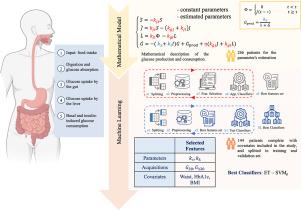Physiological model-based machine learning for classifying patients with binge-eating disorder (BED) from the Oral Glucose Tolerance Test (OGTT) curve
IF 4.8
2区 医学
Q1 COMPUTER SCIENCE, INTERDISCIPLINARY APPLICATIONS
引用次数: 0
Abstract
Background and objective:
Binge eating disorder (BED) is the most frequent eating disorder, often confused with obesity, with which it shares several characteristics. Early identification could enable targeted therapeutic interventions. In this study, we propose a hybrid pipeline that, starting from plasma glucose data acquired during the Oral Glucose Tolerance Test (OGTT), allows us to classify the two types of patients through computational modeling and artificial intelligence.
Methods:
The proposed hybrid pipeline integrates a classical mechanistic model of delayed differential equations (DDE) that describes glucose–insulin dynamics with machine learning (ML) methods. Ad hoc techniques, including structural identifiability analysis, have been employed for refining and evaluating the mathematical model. Additionally, a dedicated pipeline for identifying and optimizing model parameters has been applied to obtain reliable estimates. Robust feature extraction and classifier selection processes were developed to ensure the optimal choice of the best-performing classifier.
Results:
By leveraging parameters estimated from the mechanistic model alongside easily obtainable patient information (such as glucose levels at 30 and 120 min post-OGTT, glycated hemoglobin (Hb1Ac), body mass index (BMI), and waist circumference), our approach facilitates accurate classification of patients, enabling tailored therapeutic interventions.
Conclusion:
Initial findings, focusing on correctly categorizing patients with BED based on metabolic data, demonstrate promising outcomes. These results suggest significant potential for refinement, including exploration of alternative mechanistic models and machine learning algorithms, to enhance classification accuracy and therapeutic strategies.

基于生理学模型的机器学习,从口服葡萄糖耐量试验(OGTT)曲线对暴饮暴食症(BED)患者进行分类。
背景和目的:暴饮暴食症(BED)是最常见的饮食失调症,经常与肥胖症混淆,而肥胖症与暴饮暴食症有几个共同的特征。早期识别可实现有针对性的治疗干预。在本研究中,我们提出了一个混合管道,从口服葡萄糖耐量试验(OGTT)中获取的血浆葡萄糖数据开始,通过计算建模和人工智能对两类患者进行分类:方法:所提出的混合管道将描述葡萄糖-胰岛素动态的经典延迟微分方程(DDE)机理模型与机器学习(ML)方法相结合。在完善和评估数学模型时,采用了包括结构可识别性分析在内的特别技术。此外,为了获得可靠的估计值,还采用了专门的管道来识别和优化模型参数。开发了稳健的特征提取和分类器选择流程,以确保最佳选择性能最佳的分类器:通过利用从机理模型中估算出的参数以及容易获得的患者信息(如糖化血红蛋白(Hb1Ac)、体重指数(BMI)和腰围),我们的方法有助于对患者进行准确分类,从而实现有针对性的治疗干预:初步研究结果表明,根据代谢数据对 BED 患者进行正确分类的结果很有希望。这些结果表明,该方法还有很大的改进空间,包括探索其他机理模型和机器学习算法,以提高分类准确性和治疗策略。
本文章由计算机程序翻译,如有差异,请以英文原文为准。
求助全文
约1分钟内获得全文
求助全文
来源期刊

Computer methods and programs in biomedicine
工程技术-工程:生物医学
CiteScore
12.30
自引率
6.60%
发文量
601
审稿时长
135 days
期刊介绍:
To encourage the development of formal computing methods, and their application in biomedical research and medical practice, by illustration of fundamental principles in biomedical informatics research; to stimulate basic research into application software design; to report the state of research of biomedical information processing projects; to report new computer methodologies applied in biomedical areas; the eventual distribution of demonstrable software to avoid duplication of effort; to provide a forum for discussion and improvement of existing software; to optimize contact between national organizations and regional user groups by promoting an international exchange of information on formal methods, standards and software in biomedicine.
Computer Methods and Programs in Biomedicine covers computing methodology and software systems derived from computing science for implementation in all aspects of biomedical research and medical practice. It is designed to serve: biochemists; biologists; geneticists; immunologists; neuroscientists; pharmacologists; toxicologists; clinicians; epidemiologists; psychiatrists; psychologists; cardiologists; chemists; (radio)physicists; computer scientists; programmers and systems analysts; biomedical, clinical, electrical and other engineers; teachers of medical informatics and users of educational software.
 求助内容:
求助内容: 应助结果提醒方式:
应助结果提醒方式:


